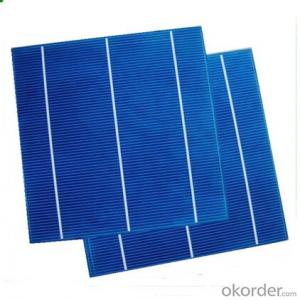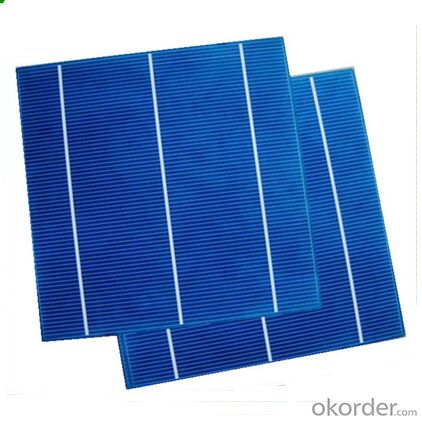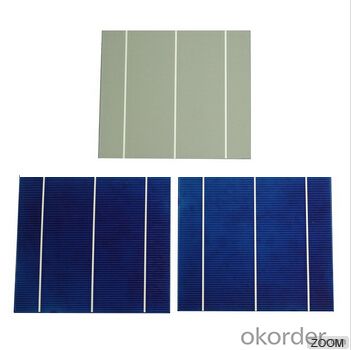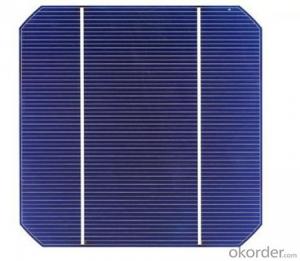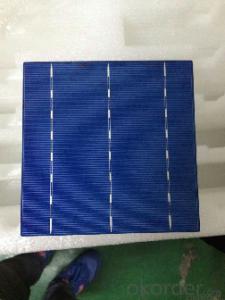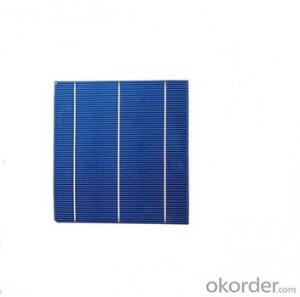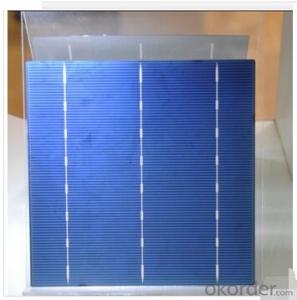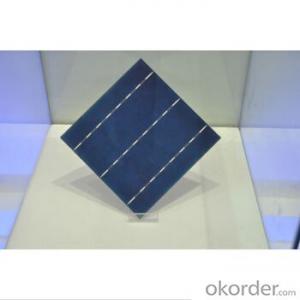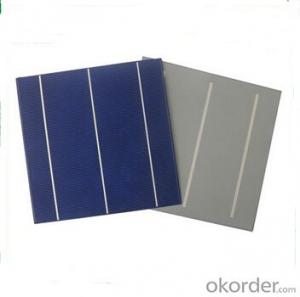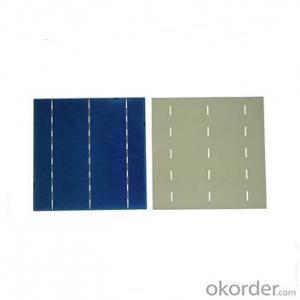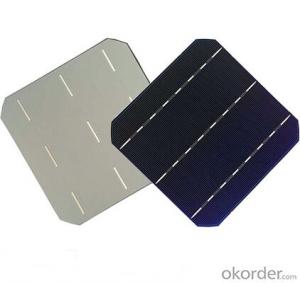High Quality Hydrocarbon Polycrystalline Solar Cells 16.80-18.00 Effy
- Loading Port:
- Shanghai
- Payment Terms:
- TT or LC
- Min Order Qty:
- 1000 pc
- Supply Capability:
- 1000000 pc/month
OKorder Service Pledge
OKorder Financial Service
You Might Also Like
Solar Cells:
solar cells, when struck by photons of light from the sun, generates an electrical current which can then be used to power DC or AC electrical loads.
A solar cell is made of silicon. Computer chips are made of this same material. Basically, when light strikes the surface of a solar cell some of it is absorbed into the silicon. This light energy bumps the electrons loose and causes energy to flow
Solar cells is made by solar wafer, it has three categories of solar cell right now, monocrystalline polycrystalline and thin film,These cells are entirely based around the concept of PN junction, which is the critical part of solar module, it is the part that can convert the light energy into electricity, the thickness is from 180um to 200um, with even busbars to conduct electricity, textured cell can decrease diffuse reflection; they are often electrically connected and encapsulated as a module. Photovoltaic modules often have a sheet of glass on the front (sun up) side, allowing light to pass while protecting semiconductor wafers from abrasion and impact due to wind-driven debris, rain, hail, etc. Solar cells are also usually connected in series in modules, creating an additive voltage. Connecting cells in parallel will yield a higher current;With high quality and stable quality. Our Cells can greatly improve the performance of Solar Modules.
Specifications
Efficiency(%) | 18.00 | 17.80 | 17.60 | 17.40 | 17.20 | 16.80 |
Pmpp(W) | 4.33 | 4.29 | 4.24 | 4.19 | 4.14 | 4.09 |
Umpp(V) | 0.530 | 0.527 | 0.524 | 0.521 | 0.518 | 0.516 |
Impp(A) | 8.159 | 8.126 | 8.081 | 8.035 | 7.990 | 7.938 |
Uoc(V) | 0.633 | 0.631 | 0.628 | 0.625 | 0.623 | 0.620 |
Isc(A) | 8.709 | 8.677 | 8.629 | 8.578 | 8.531 | 8.478 |
Solar Cells Advantage:
• High efficiency and stable performance in photovoltaic conversion.
• Advanced diffusion technique ensuring the homogeneity of energy conversion efficiency of the cell.
• Advanced PECVD film forming, providing a dark blue silicon nitride anti-reflection film of homogenous color and attractive appearance.
• High quality metal paste for back surface and electrode, ensuring good conductivity, high pulling strength and ease of soldering.
• High precision patterning using screen printing, ensuring accurate busbar location for ease with automatic soldering a laser cutting.
Features:
1. High conversion efficiencies resulting in superior power output performance
2. Outstanding power output even in low light or high temperature conditions
3. Optimized design for ease of soldering and lamination
4. Long-term stability, reliability and performance
5. Low breakage rate
6. Color uniformity
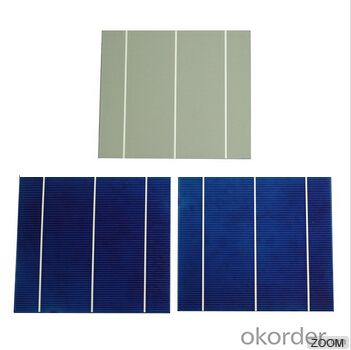
FAQ
We have organized several common questions for our clients,may help you sincerely:
①What price for each watt?
It depends on the efficiency of the solar cell, quantity, delivery date and payment terms.
②How long can we receive the product after purchase?
In the purchase of product within three working days, We will arrange the factory delivery as soon as possible. The pecific time of receiving is related to the state and position of customers.Commonly 7 to 10 working days can be served.
③Can you provide the peripheral products of the solar panels, such as the battery, controller, and inverter? If so, can you tell me how do they match each other?
Yes, we can, we have two companies for solar region, one is CNBM International, the other is CNBM engineering Co.
We can provide you not only the solar module but also the off grid solar system, we can also provide you service with on grid plant.
④What is your warranty of solar cell?
Our product can promise lower than 0.3% open box crack, we support claim after opening the box if it has crackm color difference or sth, the buyer should give pictures immediately, we can not accept the claim after the solar cell has assembled to solar panel.
• Timeliness of delivery
• ⑤How do you pack your products?
We have rich experience on how to pack the solar cell to make sure the safety on shipment, we could use wooden box or pallet as buyer's preference.
How to Make Solar Cell in Home
Solar cells have a huge usage in home. If you want to get a solar cell at home, you can light up your little things like a clock, radio, etc. And here some steps to make solar cells . First, take a copper sheet and cut it into equal parts. After cutting, you have 2 pieces of the same size. Step2: Heat up one piece of copper sheet completely using a burner or gas stove. Heat up 20 to 30 minutes. Then place it undisturbed to cool down. Step3: Attach a piece of copper wire to it. Clear that place where you will attach copper wire to it. Step 4: Take another piece of copper sheet and attach it to another piece of copper wire. Step5: Take a plastic bottle and cut it half. In the bottom part of bottle make a solution of hot water and salt. Step6: Paste burned copper sheet in the bottle. Only copper sheet touched with water not copper wire. Step7: In opposite direction paste another piece of copper sheet. Step8: Now your solar cell is ready to be attached to anything to the wire which is attached to copper sheets.
How to Build your own Solar Cell
Step 1: Stain the Titanium Dioxide with the Natural Dye: Stain the white side of a glass plate which has been coated with titanium dioxide (TiO2). This glass has been previously coated with a transparent conductive layer (SnO2), as well as a porous TiO2 film. Crush fresh blackberries, raspberries, pomegranate seeds, or red Hibiscus tea in a tablespoon of water. Soak the film for 5 minutes in this liquid to stain the film to a deep red-purple color. If both sides of the film are not uniformly stained, then put it back in the juice for 5 more minutes. Wash the film in ethanol and gently blot it dry with a tissue.
Step 2: Coat the Counter Electrode: The solar cell needs both a positive and a negative plate to function. The positive electrode is called the counter electrode and is created from a "conductive" SnO2 coated glass plate. A Volt - Ohm meter can be used to check which side of the glass is conductive. When scratched with a finger nail, it is the rough side. The "non-conductive" side is marked with a "+." Use a pencil lead to apply a thin graphite (catalytic carbon) layer to the conductive side of plate's surface.
Steps 3: Add the Electrolyte and Assemble the Finished Solar Cell: The Iodide solution serves as the electrolyte in the solar cell to complete the circuit and regenerate the dye. Place the stained plate on the table so that the film side is up and place one or two drops of the iodide/iodine electrolyte solution on the stained portion of the film. Then place the counter electrode on top of the stained film so that the conductive side of the counter electrode is on top of the film. Offset the glass plates so that the edges of each plate are exposed. These will serve as the contact points for the negative and positive electrodes so that you can extract electricity and test your cell. Use the two clips to hold the two electrodes together at the corner of the plates. The output is approximately 0.43 V and 1 MA /cm2 when the cell is illuminated in full sun through the TiO2 side.
- Q: How do solar cells impact air pollution?
- Solar cells have a significant positive impact on air pollution as they generate clean, renewable energy without emitting harmful pollutants or greenhouse gases. By reducing our reliance on fossil fuels, solar cells help mitigate air pollution and improve the overall air quality, leading to better health outcomes and a healthier environment.
- Q: Can solar cells be used for cooking?
- Yes, solar cells can be used for cooking. Solar cookers are designed to capture and convert sunlight into heat energy, which can then be used for cooking food. These cookers utilize solar cells to generate electricity, which can power electric stoves or ovens for cooking. Additionally, some solar cookers directly convert sunlight into heat using reflective surfaces and insulation, eliminating the need for electricity altogether.
- Q: How do solar cells handle electromagnetic pulses?
- Solar cells are generally not designed to handle electromagnetic pulses (EMPs) as they are highly sensitive electronic devices. Strong EMPs, such as those caused by a nuclear explosion or a solar storm, can potentially damage or destroy solar cells by overwhelming their circuitry. However, it is worth noting that the likelihood of solar cells being directly affected by EMPs is relatively low, as they are often shielded by other components of the solar panel system such as inverters and wiring.
- Q: Can solar cells be used for lighting?
- Yes, solar cells can be used for lighting by converting sunlight into electricity, which can then be used to power various types of lighting systems.
- Q: Can solar cells be used on satellites?
- Yes, solar cells can be used on satellites. In fact, they are commonly used to power satellites in space by converting sunlight into electricity.
- Q: Can solar cells be used to power water treatment plants?
- Yes, solar cells can be used to power water treatment plants. Solar energy can be converted into electricity using photovoltaic technology, which can then be utilized to power the various systems and processes involved in water treatment, such as pumps, filters, and disinfection systems. Solar power offers a sustainable and environmentally friendly solution for powering water treatment plants, particularly in areas with abundant sunlight.
- Q: Can solar cells be used in industrial applications?
- Yes, solar cells can be used in industrial applications. They are increasingly being integrated into industrial processes to generate clean and renewable energy for powering machinery, equipment, and facilities. Solar cells are utilized in various industrial sectors such as manufacturing, agriculture, mining, and logistics, contributing to reduced carbon emissions and operational costs.
- Q: Can solar cells be used in remote sensing applications?
- Yes, solar cells can be used in remote sensing applications. Solar cells can convert sunlight into electrical energy, which can power remote sensing devices and instruments. This allows for continuous and sustainable operation of remote sensing systems in areas where access to traditional power sources may be limited or unavailable. Additionally, solar cells can be integrated into small and lightweight devices, making them ideal for remote sensing applications where portability and efficiency are crucial.
- Q: What is the maximum efficiency that a solar cell can achieve?
- The maximum efficiency that a solar cell can achieve is known as the Shockley-Queisser limit, which is approximately 33.7%.
- Q: Can solar cells be used to power water pumps or irrigation systems?
- Yes, solar cells can be used to power water pumps or irrigation systems. Solar panels can convert sunlight into electricity, which can then be used to power water pumps or irrigation systems. This is a sustainable and environmentally friendly solution as it relies on renewable energy sources.
Send your message to us
High Quality Hydrocarbon Polycrystalline Solar Cells 16.80-18.00 Effy
- Loading Port:
- Shanghai
- Payment Terms:
- TT or LC
- Min Order Qty:
- 1000 pc
- Supply Capability:
- 1000000 pc/month
OKorder Service Pledge
OKorder Financial Service
Similar products
Hot products
Hot Searches
Related keywords
